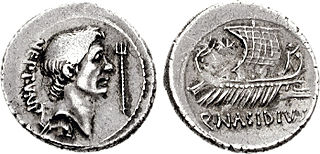Related Research Articles
The gens Gabinia was a plebeian family at ancient Rome. Members of this gens first appear in the second century BC. The nomen derives from the city of Gabii, east of Rome.

The gens Licinia was a celebrated plebeian family at ancient Rome, which appears from the earliest days of the Republic until imperial times, and which eventually obtained the imperial dignity. The first of the gens to obtain the consulship was Gaius Licinius Calvus Stolo, who, as tribune of the plebs from 376 to 367 BC, prevented the election of any of the annual magistrates, until the patricians acquiesced to the passage of the lex Licinia Sextia, or Licinian Rogations. This law, named for Licinius and his colleague, Lucius Sextius, opened the consulship for the first time to the plebeians. Licinius himself was subsequently elected consul in 364 and 361 BC, and from this time, the Licinii became one of the most illustrious gentes in the Republic.

The gens Marcia, occasionally written Martia, was one of the oldest and noblest houses at ancient Rome. They claimed descent from the second and fourth Roman Kings, and the first of the Marcii appearing in the history of the Republic would seem to have been patrician; but all of the families of the Marcii known in the later Republic were plebeian. The first to obtain the consulship was Gaius Marcius Rutilus in 357 BC, only a few years after the passage of the lex Licinia Sextia opened this office to the plebeians.
The gens Terentia was a plebeian family at ancient Rome. Dionysius mentions a Gaius Terentius Arsa, tribune of the plebs in 462 BC, but Livy calls him Terentilius, and from inscriptions this would seem to be a separate gens. No other Terentii appear in history until the time of the Second Punic War. Gaius Terentius Varro, one of the Roman commanders at the Battle of Cannae in 216 BC, was the first to hold the consulship. Members of this family are found as late as the third century AD.

The gens Porcia, rarely written Portia, was a plebeian family at Ancient Rome. Its members first appear in history during the third century BC. The first of the gens to achieve the consulship was Marcus Porcius Cato in 195 BC, and from then until imperial times, the Porcii regularly occupied the highest offices of the Roman state.
The gens Cluvia was a plebeian family at ancient Rome, known from the later Republic, and early imperial times. The first member of the gens to achieve prominence was Gaius Cluvius Saxula, praetor in 175 and 173 BC.
The gens Laelia was a plebeian family at Rome. The first of the gens to obtain the consulship was Gaius Laelius in 190 BC.
The gens Lucceia, occasionally Luceia or Luccia, was a plebeian family at Rome, which flourished during the final century of the Republic and under the early Empire.
The gens Mescinia was a minor plebeian family at Rome. None of its members held any of the higher magistracies, but Lucius Mescinius Rufus, perhaps the most famous of the gens, was quaestor under Cicero during the latter's administration of Cilicia. Other Mescinii are known from inscriptions.

The gens Munatia was a plebeian family at Rome. Members of this gens are first mentioned during the second century BC, but they did not obtain any of the higher offices of the Roman state until imperial times.

The gens Nasidia was an obscure plebeian family at Rome. The gens is best known from Quintus Nasidius, one of the admirals of Gnaeus Pompeius Magnus during the Civil War. Although none of the Nasidii are known to have held any of the higher offices of the Roman state, a number are known from inscriptions. A coin of this gens depicts the head of Pompeius and a trident on the obverse, and on the reverse a ship, with the inscription Q. Nasidius.

The gens Neria was a minor plebeian family at Rome. Members of this gens are first mentioned in the time of Caesar, when Gnaeus Nerius was quaestor, but few if any others are known to have held Roman magistracies. Many Nerii are known from inscriptions. A coin issued by the quaestor Nerius depicts the head of Saturn on the obverse, and standards labeled with the names of the consuls on the reverse, perhaps alluding to Caesar having broken open the treasury, or showing the legitimacy of the Senate to the legions against the rebellion of Caesar.
The gens Petreia was a minor plebeian family at ancient Rome. Members of this gens are first mentioned toward the end of the second century BC, and several were distinguished as soldiers, but none of them ever attained the consulship.
The gens Pilia was an obscure plebeian family at ancient Rome. None of the Pilii attained any of the higher magistracies of the Roman state, and members of this gens are known primarily through the writings of Cicero, who was acquainted with a family of this name; but many others are known from inscriptions.

The gens Plancia was a minor plebeian family of equestrian rank at ancient Rome. Few members of this gens are mentioned in the time of the Republic, but a family of the Plancii rose to prominence from the time of Vespasian, and held a number of important magistracies through the time of Hadrian. Other Plancii are known from inscriptions.
The gens Racilia was a minor plebeian family at ancient Rome. Members of this gens are mentioned as early as the fifth century BC, but few of them achieved any prominence in the Roman state.
The gens Sallustia, occasionally written Salustia, was a plebeian family at ancient Rome. Members of this gens are first mentioned in the time of Cicero, and from that time they attained particular distinction as statesmen and writers. The most illustrious of the family was the historian Gaius Sallustius Crispus, who wrote valuable works on the Jugurthine War and the Conspiracy of Catiline, which still exist.
The gens Carrinatia was a plebeian family at ancient Rome. Members of this gens rose to prominence during the final century of the Republic, attaining the consulship in 43 BC.

The gens Statilia was a plebeian family of Lucanian origin at ancient Rome. Members of this gens are first mentioned in the third century BC, when one of them led the Lucanian assault on the city of Thurii, and another commanded an allied cavalry troop during the Second Punic War; but at Rome the Statilii first come to attention in the time of Cicero, at which point they held equestrian rank. The first of the family to attain the consulship was Titus Statilius Taurus in 37 BC, and his descendants continued to fill the highest offices of the Roman state until the time of Marcus Aurelius.
The gens Tuscenia was an obscure plebeian family at ancient Rome. Few members of this gens appear in history, but others are known from inscriptions.
References
- 1 2 Dictionary of Greek and Roman Biography and Mythology, vol. III, p. 495 ("Gaius Pomptinus").
- ↑ Frontinus, Strategemata, ii. 4. § 8.
- ↑ Sallust, Bellum Catilinae, 45.
- ↑ Cicero, In Catilinam, iii. 2, De Provinciis Consularibus, 13, In Pisonem, 14, Epistulae ad Atticum, iv. 16, v. 1, 4–6, 8, 10, 14, 21. § 9, vi. 3, Epistulae ad Quintum Fratrem, iii. 4. § 6, Epistulae ad Familiares, ii. 15. § 4, iii. 10. § 3, xv. 4. § 9.
- ↑ Cassius Dio, xxxvii. 47, xxxix. 65.
- ↑ Livy, Epitome, 103.
- ↑ Broughton, vol. II, pp. 167, 181, 191.
- ↑ CIL VIII, 1911.
- 1 2 3 CIL VI, 200.
- ↑ CIL VI, 24686.
- ↑ CIL VI, 36851.
- ↑ CIL XI, 4368.
- ↑ CIL XII, 5825.
- ↑ CIL VI, 10338.
- ↑ CIL VI, 24684.
- ↑ BCAR, 1923-79.
- ↑ CIL VI, 28426.
- 1 2 3 BCAR, 1925-205.
- ↑ CIL VIII, 1886.
- ↑ CIL VI, 5009.
- ↑ CIL XIII, 14.